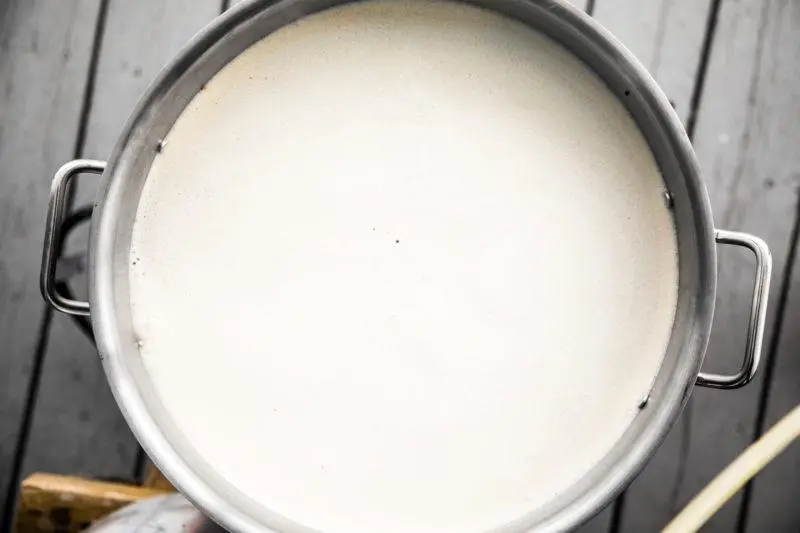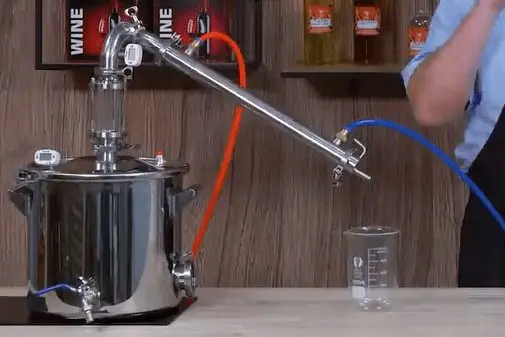Contents
For several years I have been engaged in the production of alcohol, cognac and whiskey. And my main goal is to get the purest product that can only be driven out at home.
I usually ferment mash with good imported yeast for less than a week. If I do not have time to process it on a moonshine still, I keep it longer.
Several times at the beginning of my hectic activity as a moonshiner, I had a situation where, during distillation, the initial temperature of the appearance of the distillate was too high – more than 90 degrees. I didn’t understand why this was happening, because with normal mash, this temperature is about 85 degrees.
Reasons for the appearance of sweetness in Braga
I decided to check the liquid left after distillation (sometimes called vinasse). After the distillation of sugar mash bard, it turns out clean, transparent, there is little sediment. I chilled the bard and tasted it.
She was sweet. At first, I didn’t even understand where the sugar in the water came from, which the yeast had been grinding for a week.

Braga is wandering.
Searching the Internet, I found the reasons for the remaining sugar:
- poor quality yeast;
- excess sugar dissolved in water;
- oxygen access;
- dirty water;
- high alcohol content (waste products of yeast);
- incorrect fermentation temperature.
Of all these reasons, I obviously had a water-to-sugar ratio that was off. A year ago, sugar was very cheap, and I thought that if I added less water to the mash, it would turn out to be more alcoholic. However, the yeast apparently simply died in such a solution. After all, a person cannot live in a jar of condensed milk.
Braga is sweet and does not ferment – how to fix it
Since moonshiners often brew in large vats or even barrels, dead yeast will cause most of the sugar to simply disappear. I have a 30-liter container in which you need to dilute sugar about 10 kilograms.
If fermentation stops, then it is a pity to throw away even half of this sugar. Based on the reasons I found on the Internet, I did the following:
- I poured the mash into another container and poured out a cloudy sediment (obviously, there is a lot of dead yeast and you need to get rid of them).
- He heated the mash to a temperature of 27-28 degrees.
- I diluted it with fresh clean water, passed through the Barrier filter.
- I added another half pack of wine yeast and it started working again.

Fermented second time mash.
The figure shows that there are no more bubbles. The taste of the newly fermented mash was already much less sweet, however, sugar remained in it.
Is it possible to overtake such a mash
I had no choice but to pour the mash into a distillation column and start distilling it. The temperature of the mash, at which the distillate began to stand out from the refrigerator, was 88 degrees.
Let me remind you that it is usually 85 degrees, which means that the strength of the mash is much lower than usual.

Distillation column in distiller mode.
I must say that this temperature depends entirely on the alcohol content of the mash. Despite the fact that it is written on expensive yeast that they give out mash with a strength of 20 degrees at the exit – do not believe it. I have never been able to drive her out on more than 15 degrees of alcohol.
If the mash is not fertile for some reason, its alcohol content is less than 10 degrees. If the fermentation process went well, and I keep the mash longer – up to 2 weeks, the alcohol content can be 15 degrees. Depending on this, the distillation temperature also changes.
That is, I overtook this mash anyway, but the remaining bard was sweetish.
Braga was good, but sweet – what to do so as not to lose sugar
Once I forgot to check the mash with an alcohol meter and did not taste it. Poured into a distillation column and began to heat it. After 40 minutes, the temperature jumped to 92 degrees and distillate poured out of the refrigerator.
I realized that I started distilling mash, in which the yeast died for some reason, and could not process all the sugar.
I had no choice but to continue the distillation. After all, the yeast had already died when heated and there was no point in putting the mash again. But I also felt sorry for throwing out a large amount of sugar, and I decided to use the stillage for a new fermentation.
For this I:
- cooled the stillage to room temperature;
- added the same volume of pure water, and sugar – half as much as it should be according to the usual recipe;
- poured new yeast;
- installed a lid with a water seal (so that oxygen does not penetrate to the mash and does not kill the yeast.
As a result, after two weeks I managed to get a new mash with an alcohol content of 13 degrees. That is, I practically did not lose sugar. In the future, of course, I no longer made such mistakes. And if the mash remained sweet, he immediately corrected the process, as described in the second paragraph of the story.
Have you had to fix sweet mash and what were the reasons for sweetness?
*Alcohol abuse is dangerous for your health!









